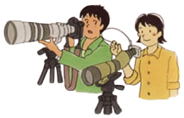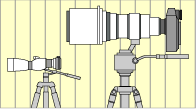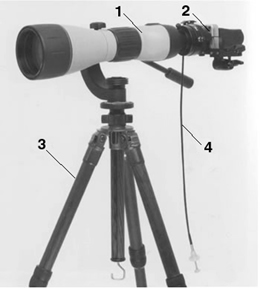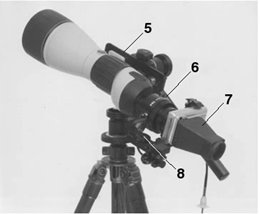
Welcome to the digiscoping world
Haven't you ever had a experience that the objective images was too timid to see against your expectation even if you wanted to take a picture of the beautiful bird. At that time, did you think an very expensive digital SLR camera with a super-telescoping lens was indispensable if you want to capture a close-ups of a small bird ?
As a matte of fact, there is a very convenient system, which is connecting a spotting scope or a monocular to a digital SLR camera or a compact digital camera to take a up-close picture. The mechanism of this system is to use a spotting scope or a monocular as a substitute lens of a telescope lens or a macro lens, allowing to take a super-telephoto and a super-macro shooting. Digiscoping lovers have increased in number year by year. The roll of a telescope has been changing from "looking" to "pictorial recording" and "sharing pictures with friends on the Internet."Spotting
scopes have lately attracted considerable attentions as a super-telephoto lens and a super-macrophoto lens.


This is the power of digiscoping.

50mm

100mm

300mm

500mm

1000mm

2000mm

4000mm

7000mm
1. More close-up images than expected
The idea of digiscoping system is connecting a spotting scope or a monocular to a digital SLR camera or a digital compact camera.
Shooting example: After setting the 3x in-zoom digital compact camera behind the high magnification spotting scope, taking shots of the same subjects from the same place. The distance to the subject is approximately 20m.
The most up picture is the captured image through 50mm standard lens (35mm format calculation) on a LCD panel.
Where is the bird model? You can manage to see it by 300-500mm, and it becomes full frame by1000-2000-4000mm,
Capability of 7000mm of a digiscoping allows you to capture close-up images of a duck’s face 20m distance.
Not only a compact camera but also SLR is also recommendable. Current compact digital SLR cameras are low price and light weight so that you can get it. It is possible to take a super-telephoto shooting easily if you attach a scope lens instead of an interchangeable lens to a camera via an adapter. The advantages of digital SLR camera make it possible for you to bring your camera into focus by the optical finder, and best suit a instantaneous shooting because of the short shatter time lag. The image pixel size of each camera varies the focal length (35mm format calculation)
2. Further more, Light weight and compact
 Digiscoping system has an advantage. Compared a digital SLR camera with a equivalent magnification super-telephoto lens, the compactness is outstanding. "light, small and easy-to-handle" allows us to take a picture easily and moves you to go out. The weight of a digital SLR camera loaded a super-telescope lens is around 15 kg.
Digiscoping system has an advantage. Compared a digital SLR camera with a equivalent magnification super-telephoto lens, the compactness is outstanding. "light, small and easy-to-handle" allows us to take a picture easily and moves you to go out. The weight of a digital SLR camera loaded a super-telescope lens is around 15 kg.
The average of total weight of digiscoping is 4-5 kg, therefore there is a big difference between them. When it comes to a digiscoping system, changing a scope into a small monocular, its weight will become 1.5 kg , and it’s up to cameras for you to capture the image of 800mm equivalent focal length.
As you can approach to the subject with the minimal shooting distance of 30cm, you can capture close-up images of wild grass or insects.
3. Easy confirmation right after shooting & convenience of the prior confirmation before shooting
 As the quick confirmation of the image on a L.C.D panel after shooting, it is one of the attractions that the prompt check of the image composition, focusing and the blur of the subject are adjustable.
As the quick confirmation of the image on a L.C.D panel after shooting, it is one of the attractions that the prompt check of the image composition, focusing and the blur of the subject are adjustable.
Some of compact cameras and digital S.L.R. cameras help you to see “frame images” on a monitor panel at all times.
Anyone can take a good picture ,because you will be able to have a pre-images of the subjects' location, focusing conditions and frame images composition.

Prime equipments of a digiscoping
Digiscoping system is mainly composed of 8 parts as follows:

- 1.Scope & eyepiece lens: By combining a scope(the focal length 400-500mm) with the magnifications of eyepiece lens(2x-6x), one ends up with a total magnification of 60x (approximately 800-3000mm)
- 2.Compact digital camera: Setting up the optical 3x zoom-in camera to the above equipments produces images of equivalent 2400-9000mm on a L.C.D. monitor panel.
- 3.Tripods & camera platforms: Vibration or blur happens to be caused by your finger shaking and equipments by themselves. You had better choose,a stable tripod to stabilize your equipment adjustable angles and up-and-down movement smoothly.
- 4. Cable releases: In case of a super-telescope shooting, when you press shatter button, 1mm optical error by a equipment vibration makes 10-20cm errors what it should have to be. In order to reduce such a mistake, a cable release is a indispensable. Currently wired remote shutter have been produced in number. You had better use this device if you have it.

- 5.Balance-plate: This is a important device to keep balance of a camera and a scope, and matching the fulcrum of a tripod. You can not take a picture without it comfortably.
- 6.Adapters & camera brackets: Attachment to a scope unit. There are various types of them applicable to several kind of scope eyepiece lens and cameras.
- 7.L.C.D. monitor shade hood: It is hardly for you to look at subjects on a L.C.D monitor under the sunny light.
Therefore, you need a light prevention shade hood, allowing to focus easily. - 8.A sight device: It is very hard to capture the close-up image in a frame properly by a digital camera with more than focal length 2000mm. Therefore it’s convenient that you had better take a shot after capturing the subject through a sight device with the same magnification rate of the camera.
A digital S.L.R camera needs an exclusive adaptor between a scope and a camera. So many camera makers, so many the mounted shapes of lens attachment part. Therefore check your scope and adaptor maker , or on the makers home-page. Further more, a tripod should be stable as well as a S.L.R. camera.